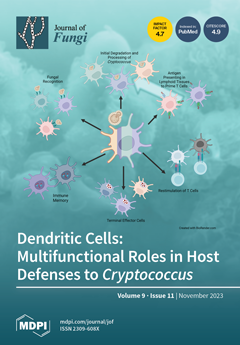Putative methyltranferase LaeA and LaeA-like proteins, conserved in many filamentous fungi, regulate fungal growth, development, virulence, the biosynthesis of secondary metabolites, and the production of cellulolytic enzymes.
Penicillium oxaliucm is a typical fungus that produces cellulolytic enzymes. In this study, we reported the
[...] Read more.
Putative methyltranferase LaeA and LaeA-like proteins, conserved in many filamentous fungi, regulate fungal growth, development, virulence, the biosynthesis of secondary metabolites, and the production of cellulolytic enzymes.
Penicillium oxaliucm is a typical fungus that produces cellulolytic enzymes. In this study, we reported the biological function of eight putative methyltransferases (PoMtr23C/D/E/F/G/H and PoMtr25A/B) containing a methyltransf_23 or methyltransf_25 domain, with a focus on their roles in the production of cellulolytic enzymes. In
P. oxalicum, various methyltransferase genes displayed different transcriptional levels. The genes Po
mtr23C and Po
mtr25A exhibited high transcriptional levels, while Po
mtr23D/
E/
F/
G/
H and Po
mtr25B were transcribed constantly at low levels. The gene deletion mutants (Δ
mtr23C/
D/
E/
F/
G/
H and Δ
mtr25A/
B) were constructed. Various mutants have different patterns in cellulolytic enzyme production. Compared to the WT, the largest increase in filter paper activity (FPA, indicating total cellulase activity) was observed in the Δ
mtr23G mutant, the only mutant with a cellulolytic halo surrounding the colony. Three mutants (Δ
mtr23C/
D and Δ
mtr25A) also showed increased cellulolytic enzyme production. The Δ
mtr23E and Δ
mtr25B mutants displayed decreased FPA activity, while the Δ
mtr23F and Δ
mtr23H mutants displayed similar patterns of cellulolytic enzyme production compared with the WT. The assay of transcriptional levels of cellobiohydrolase gene Po
cbh1 and β-1,4-endoglucanase Po
eg1 supported that higher cellulolytic gene transcription resulted in higher production of cellulolytic enzymes, and vice versa. The transcriptional levels of two transcription factors, activator XlnR and repressor CreA, were measured. The high transcription level of the Po
xlnR gene in the Δ
mtr23D mutant should be one reason for the increased transcription of its cellulolytic enzyme gene. Both XlnR and CreA transcriptional levels increased in the Δ
mtr23G mutant, but the former showed a more significant increase than the latter, indicating that the activation effect predominated. The PoMtr25A is localized in the nucleus. The catalytic subunit SNF2 of the SWI/SNF chromatin-remodeling complex was found as one of the interacting proteins of PoMtr25A via tandem affinity purification coupled with mass spectrometry. PoMtr25A may affect not only the transcription of repressor CreA but also by recruiting SWI/SNF complexes that affect chromatin structure, thereby regulating the transcription of target genes.
Full article






